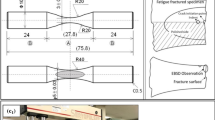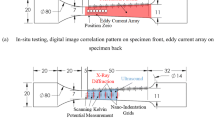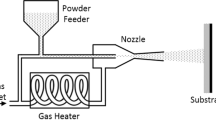Abstract
The stable tearing behavior of 2.3-mm thick sheets of 2024-T3 aluminum alloy was experimentally investigated for middle crack tension specimens having initial flaws that were: (a) flat fatigue cracks (low fatigue stress) and (b) 45-deg through-thickness slant cracks (high fatigue stress). The critical CTOA values during stable tearing were measured by two independent methods, optical microscopy and digital-image correlation. Results from the two methods agree well.
The CTOA measurements and observations of the fracture surfaces have shown that the initial stable tearing behavior of low and high fatigue stress tests is significantly different. The cracks in the low fatigue stress tests underwent a transition from flat-to-slant crack growth, during which the CTOA values were high and significant crack tunneling occurred. After crack growth equal to about the thickness (Δa>B), CTOA reached a constant value of 6 deg and after crack growth equal to about twice the thickness (Δa>2B), crack tunneling stabilized. The cracks in the high fatigue stress tests reach the same constant CTOA value after crack growth equal to about the thickness, but produced only slightly higher CTOA values during initial crack growth. The amount of tunneling in the high fatigue stress tests was about the same as that in the low fatigue stress tests after the flat-to-slant transition.
This study indicates that stress history has an influence on the initial portion of the stable tearing behavior. The initial high CTOA values, in the low fatigue crack tests, coincided with large three-dimensional crack front shape changes due to a variation in the through-thickness crack-tip constraint. The measured CTOA reached a constant value of 6 deg for crack growth of about the specimen thickness. This coincided with the onset of 45-deg slant crack growth and a stabilized, slightly tunneled (about 20 percent of the thickness) crack-front shape. For crack growth on the 45-deg slant, the crack front and local field variables are still highly three dimensional.
Similar content being viewed by others
References
Sampath, S.G., Abou-Sayed, I.S., Broek, D., Marschall, C., Zahoor, A., and Kanninen, M.F., “The Analysis of Stable Crack Growth in Type 304 Stainless Steel,” Proc. Int. Conf. of Fract., 1759–1768 (1980).
Anderson, H., “Finite Element Representation of Stable Crack Growth,”J. Mech. and Phys. of Solids,21,337–356 (1973).
de Koning, A.U., “A Contribution to the Analysis of Quasi Static Crack Growth in Steel Materials,”Fracture 1977, Proc. 4th Int. Conf. on Fract.,3,25–31 (1977).
Wells, A.A., “Unstable Crack Propagation in Metals: Cleavage and Fast Fracture,”Proc. Cranfield Crack Propagation Symp.,1,210–230 (1961).
Wells, A.A., “Application of Fracture Mechanics at and Beyond General Yielding,”Brit. Welding J.,11,563–570 (1961).
Wells, A.A., “Notched Bar Tests, Fracture Mechanics and Brittle Strengths of Welded Structures, Brit. Welding J.,12,2–13 (1963).
Broberg, K.B., “On Stable Crack Growth,”J. Mech. and Phys. of Solids,23,215–237 (1975).
Orowan, E., “Fracture and Strength of Solids,”Report of Progress in Physics, Phys. Soc. of London,12,185–233 (1949).
Rice, J.R., “A Path Independent Integral and the Approximate Analysis of Strain Concentration by Notches and Cracks,”ASME J. Appl. Mech.,35,379–368 (1968).
Landes, J.D. and Begley, J.A., “The Effect of Specimen Geometry on J ic′ ” ASTM STP 514, Part II, 24–39 (1972).
Hutchinson, J.W., “Plastic Stress and Strain Fields at a Crack Tip,”J. Mech. Phys. of Solids,16,13–31 (1968).
Rice, J.R. andRosengren, G.F., “Plane Strain Deformation Near a Crack Tip in a Power-Hardining Material,”J. Mech. Phys. of Solids,16,1–12 (1968).
Dean, R.H., “Elastic-Plastic Steady Crack Growth in Plane Stress”,ASTM STP 803, ASTM, Philadelphia, 83 (1983).
Shih, C.F., de Lorenzi, H.G. andAndrews, W.R., “Studies on Crack Initiation and Stable Crack Growth,”ASTM STP 668, ASTM, Philadelphia, 65–120 (1974).
Shih, C.F., Dean, R.H., and German, M.D., “On J-Controlled Crack Growth: Evidence, Requirements and Applications,” General Electric Co., T13 Report, Schenectady (1981).
Hutchinson, J.W. andParis, P.C., “Stability Analysis of J-Controlled Crack Growth,”ASTM STP 668, ASTM, Philadelphia, 37–64 (1979).
McMeeking, R.M. andParks, D.M., “On Criteria for J-Dominance of Crack-Tip Fields in Large-Scale Yielding,”ASTM STP 668, ASTM, Philadelphia, 175–194 (1979).
Kang, B.S.-J. andKobayashi, A.S., “J-Estimation Procedure based on Moiré interferometry data,”ASME J. Press. Vessel Tech.,110,291–300 (1988).
Kang, B.S.-J. andKobayashi, A.S., “Stable Crack Growth in Aluminum Tensile Specimens,”Experimental Mechanics,27,234–245 (1987).
Dadkhah, M.S. andKobayashi, A.S., “HRR Field of a Moving Crack, an Experimental Analysis,”Eng. Fract. Mech.,34,253–262 (1989).
Dadkhah, M.S. andKobayashi, A.S., “Further Studies in the HRR Field of a Moving Crack, an Experimental Analysis,”J. Plasticity,6,635–650 (1990).
Kobayashi, A.S., Dadkhah, M.S. and Kang, B.S.-J. “J-Integral and HRR Field of a Stably Growing Crack, an Experimental Analysis,” UWA/DME/TR-90/65, Office of Naval Res. (April 1990).
Drinnon, R.H. andKobayashi, A.S., “J-Integral and HRR Field Associated with Large Crack Extension,”Eng. Fract. Mech.,41 (5),684–694 (1992).
Dadkhah, M.S., Kobayashi, A.S., and Morris, W.L., “Crack Tip Displacement Fields and J r -Curves for Four Aluminum Alloys,”ASTM STP 1131,11,135–153 (1992).
Davidson, D.C., “The Distribution of Strain with Crack Tip Plastic Zones,”Eng. Fracture Mechanics, Vol. 25,No. 1,pp.123–132,1986).
Rice, J.R. andSorensen, E.P., “Continuing Crack-Tip Deformation and Fracture for Plane strain Crack Growth in Elastic-Plastic Solids,”J. Mech. and Phys. of Solids,26,163–186 (1978).
Shih, C.F., “Studies on Crack Initiation and Stable Crack Growth,” ASTM STP, 668, 65–120 (1979).
Shih, C.F., de Lorenzi, H.G. andAndrews, W.R., “Elastic-Plastic Fracture,”ASTM STP 668, ASTM, Philadelphia, 65 (1979).
Hellman, D. and Schwalbe, K.-H., “Geometry and Size Effects on J-R and δ-R Curves Under Plane Stress Conditions,” ASTM STP 833, 577–605 (1984).
Hellman, D. and Schwalbe, K.-H., “On the Experimental Determination of CTOD Based R-Curves,” Proc. Conf. on Crack Tip Opening Displacement in Elastic-Plastic Fracture Mechanics, Springler-Verlag, 115–132 (1986).
Kanninen, M.F., Popelar, C.H., andBroek, D. “A Critical Survey on the Application of Plastic Fracture Mechanics to Nuclear Pressure Vessels and Piping,”Nuclear Eng. and Design,67,27–55 (1981).
Kanninen, M.F., Advanced Fracture Mechanics, Oxford University Press (1985).
Demofonti, G. and Rizzi, L., “Experimental Evaluation of CTOA in Controlling Unstable Ductile Fracture Propagation,” ESIS Pub. 9, 693–703 (1991).
Newman, J.C., Jr., Dawicke, D.S., and Bigelow, C.A., “Finite-Element Analysis and Measurement of CTOA During Stable Tearing in a Thin-Sheet Aluminum Alloy,” Proc. Int. Workshop on Structural Integrity of Aging Airplanes (April 1992).
Newman, J.C., Jr. “An Elastic-Plastic Finite Element Analysis of Crack Initiation, Stable Crack Growth, and Instability,” ASTM STP 833, 93–117 (1984).
Newman, J.C., Jr., Shivakumar, K.N., andMcCabe, D.E., “Finite Element Fracture Simulation of A533B Steel Sheet Specimens,”ESIS Pub. 9, 117–126 (1991).
Brocks, W. andYuan, H. “Numerical Studies on Stable Crack Growth,”ESIS Pub. 9, 19–33 (1991).
Hom, C.L. andMcMeeking, R.M., “Large Crack Tip Opening in Thin, Elastic-Plastic Sheets,”Int. J. Fract.,45,103–122 (1980).
Newman, J.C., Jr., Bigelow, C.A., and Shivakumar, K.N., “Three-Dimensional Elastic-Plastic Finite-Element Analysis of Constraint Variations in Cracked Bodies,” NASA TM 107704 (1993).
Sommer, E. and Aurich, D., “On the Effect of Constraint on Ductile Fracture,” Proceedings of the European Symposium on Elastic-Plastic Fracture Mechanics, ESIS/EGF Publication 9, 141–175 (1991).
Sutton, M.A., Bruck, H.A., Chae, T.L., andTurner, J.L., “Experimental Investigations of Three-Dimensional Effects Near a Crack Tip Using Computer Vision,”Int. J. Fract.,53,201–228 (1991).
Sutton, M.A., Bruck, H.A., andMcNeill, S.R., “Determination of Deformations Using Digital Correlation with the Newton Raphson Method for Partial Differential Correction,”Experimental Mechanics,29 (3),261–267 (1989).
Sutton, M.A., Turner, J.L., Chae, T.L., and Bruck, H.A., “Development of a Computer Vision Methodology for the Analysis of Surface Deformation in Magnified Image,” ASTM STP 1094, MICOM 90, 109–132 (1990).
Sutton, M.A., Turner, J.L., Bruck, H.A., andChae, T.L., “Full-Field Representation of the Discretely Sampled Surface Deformation for Displacement and Strain Analysis,”Experimental Mechanics,31 (2),168–177 (1991).
Sutton, M.A. andMcNeill, S.R., “The Effects of Subpixel Image Restoration on Digital Correlation Error Estimates,”Opt. Eng.,27, (3),163–175 (1988).
Dohrmann, C.R. and Bushy, H.R., “Spline Function Smoothing and Differentiation of Noisy Data on a Rectangular Grid,” Proc. VI International Conference on Exp. Mech., 843–849 (1988).
Gang, H., Sutton, M.A., Chao, Y.J., and Lyons, J.S., “Ductile Crack Blunting, Initiation and Crack Growth Analysis of 304 Stainless Steel Specimens by Computer Vision,” Proc. 1993 SEM Spring Conf. on Exp. Mech. (1993).
Zuidema, J. andBlaauw, H.S., “Slant Fatigue Crack Growth in Al 2024 Sheet Material,”Eng. Fract. Mech.,29 (4),401–413 (1988).
Yang, S., Chao, Y.J. andSutton, M.A., “Complete Theoretical Analysis for Higher Order Asymptotic Terms and the HRR Zone at a Crack Tip for Mode I and Mode II Loading of a Hardening Material,”ACTA Mech.,98,79–98 (1993).
Author information
Authors and Affiliations
Rights and permissions
About this article
Cite this article
Dawicke, D.S., Sutton, M.A. CTOA and crack-tunneling measurements in thin sheet 2024-T3 aluminum alloy. Experimental Mechanics 34, 357–368 (1994). https://doi.org/10.1007/BF02325151
Received:
Revised:
Issue Date:
DOI: https://doi.org/10.1007/BF02325151




